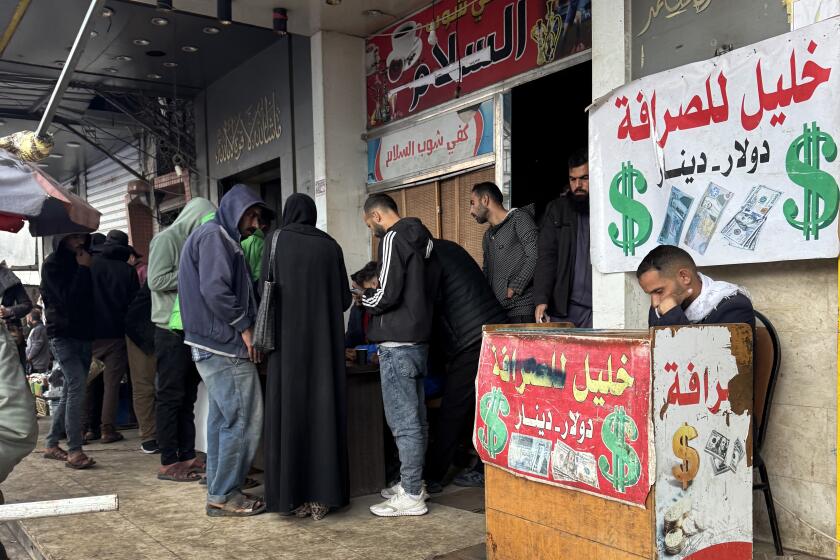Graffiti Haven’t a Prayer If Holy Image Is There
Emilia Garcia has been robbed at gunpoint half a dozen times in the nine years she’s owned her Lincoln Heights store, La Guadalupana.
But no criminal has dared touch the mural of the Virgin of Guadalupe painted outside. Even as taggers and gang members scribble graffiti on every adjacent wall, the painting remains pristine. Garcia believes that she and her business have been protected by the mural.
“The Virgin, for us Catholics, is our mother,” said Garcia, a native of the Mexican state of Jalisco. “Everyone has a picture of their mother. Maybe that’s why everyone respects her.”
Faith and entrepreneurial self-interest have found a common cause in the serene image of the Virgen de Guadalupe, the dark-skinned icon of Mexican Catholicism. Hundreds of murals of la Virgen cover storefronts in Latino neighborhoods from the Eastside to the San Fernando Valley, where the holy image is perhaps the only protection against the spray-painted noms de guerre of taggers and gang members.
At Garcia’s store, pious neighbors cross themselves when they pass by the mural. The artist, an ex-gang member, capped off his 10-foot high painting of the Virgin Mary with a message to those who might consider defacing her: “Respect Please.”
He need not have bothered. Ask any street tough if he would paint graffiti on the Holy Mother, and he will give you an unequivocal no. Some things, it seems, are still sacred.
“Anyone who writes on these knows they’re going to get racked up,” said Paris Hernandez, 23, one of a group of gang members gathered beneath a huge mural of the Virgin at the Ramona Gardens housing projects in Boyle Heights.
“I don’t really trip on her,” he continued. “If I pray, I pray straight to God. But I respect her because she’s the mother of God. She was pregnant through the spirit.”
Just a few paces from the Virgin Mary is a two-story-high mural that brings together a string of images from Mexican American pop culture: a turn-of-the-century Mexican revolutionary, an ancient Aztec warrior and some very modern-looking homeboys. It has been vandalized with a series of gang monikers.
Asked why this painting is defaced, Hernandez said, “Nobody sees this mural the way they see the other one.”
Highland Park muralist Chaz Bojorquez said representations of la Virgen de Guadalupe--also known as la Lupita, la Tia Lupe and la Guadalupana--don’t have to be painted by a professional artist to be effective against graffiti.
“It’s OK if they’re done by a child or by an amateur,” he said. “In fact, it’s probably better if the Virgen is rendered by the common man.”
Bojorquez said it’s unfortunate that a similar respect is not always paid to the many finely executed murals that portray more secular subjects.
“I have seen absolutely beautiful murals really messed up and tagged up,” he said. “The problem is, as beautiful as they are, people in the Latino community have no affinity for the things they portray.”
At liquor stores, botanicas and butcher shops, the Virgin shares wall space with ads for malt beer and herbal medicines. The Alhambra-based muralist known as Man One said he has seen some “horrible-looking Virgens” that nevertheless have escaped desecration.
“No matter how bad the neighborhood, people don’t tag on churches or the Virgin,” he said. “It’s like voodoo or something. People think something bad is going to happen.”
Unlike many other muralists, Man One has resisted requests from business owners to paint the Virgin of Guadalupe.
“It’s the first thing they think about putting on a wall,” he said. Sometimes Man One will complete a mural unrelated to the Virgin of Guadalupe, only to be directed by a store owner to another blank wall and asked, as an afterthought, if he would like to paint the Virgin.
“I think the Virgins you see are 70% spiritual pride and 30% graffiti prevention,” he said.
Itinerant muralist Alex Lopez Franco said he has painted about 25 images of the Virgin of Guadalupe on Latino businesses.
His murals, executed with a spray can, include his beeper number so other store owners can commission their own portraits.
Although the price of murals with other subject matter is open to negotiation, Franco said, he and his associate Ruben Escobedo never haggle over the price of religious murals--particularly the Lady of Guadalupe.
Sometimes, Franco said, he will tailor his mural to the type of business. If the wall belongs to a butcher, for example, he might draw the Virgin against the backdrop of a farm.
“The Virgin is a protectress,” he said. “An old drunkard, a gang member or any other person can walk by and be seen making the sign of the cross. The Virgin transmits something very special. Painting her is a very spiritual experience.”
The legend of the Virgin of Guadalupe began in 1531, when the mother of Jesus was said to have appeared to a Nahuatl Indian, Juan Diego, near the village of Guadalupe Hidalgo, just outside Mexico City. It was a time when Spanish missionaries were pressing the indigenous population to convert to Christianity. Subsequent miracles led to the building of the magnificent Basilica of Our Lady of Guadalupe.
Muralist Barbara Carrasco said the indigenous, humble features of the Virgin of Guadalupe make her a reflection of a Latina mother. This, she thinks, may explain in part why gang members and taggers are reluctant to vandalize storefronts decorated with the Virgin’s image.
“People can relate to her, especially the poor and down-and-out,” Carrasco said. “I don’t blame store owners for using the Virgin to ward off gang activities and graffiti. If it works, it’s a good thing not only for the store but the community around it. Even if the store owner doesn’t believe in the Virgin, it still helps.”
The Virgin of Guadalupe is so popular that even non-Catholics and non-Latino store owners put up her image. The Iranian owner of convenience store in Boyle Heights said he was proud to have a 100-foot-long mural of la Virgen.
Father Greg Coiro, spokesman for the Los Angeles Archdiocese, said he has seen a handful of evangelical churches try to attract followers by placing the Virgin of Guadalupe on their storefronts.
“People see the familiar image of the Virgen de Guadalupe, and so they walk inside,” he said.
Still, it is clear that the Virgin’s value extends beyond shielding against vandalism.
Emilia Garcia said her faith in the Virgin has helped her endure the long hours she works alone at her small liquor store. “La Virgen is someone who is always with you,” she said. “You are never alone.”
The Virgin has also helped her survive those harrowing robberies, she said, invoking her name.
“When I was robbed, the first thing I’d say was: Madre mia de Guadalupe,” she said.
More to Read
Sign up for Essential California
The most important California stories and recommendations in your inbox every morning.
You may occasionally receive promotional content from the Los Angeles Times.












